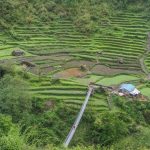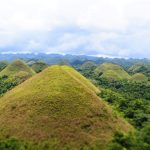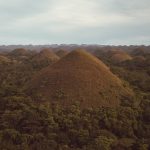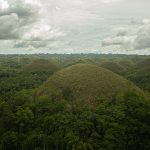Marvel at the Banaue Rice Terraces
Description
The Banaue Rice Terraces, often referred to as the “Eighth Wonder of the World,” boast a rich history that dates back over 2,000 years. These terraces were carved into the mountains of Ifugao Province in the Philippines by the indigenous Ifugao people, who developed sophisticated agricultural techniques to cultivate rice in a challenging mountainous environment. The construction of these terraces is believed to have begun around 2000 B.C., although some estimates suggest that the rice cultivation practices may have started even earlier.
The terraces are not merely agricultural fields; they represent a deep connection between the Ifugao people and their land, showcasing their ingenuity and resilience in adapting to their environment. The historical significance of the Banaue Rice Terraces extends beyond their agricultural function. They are a testament to the Ifugao’s cultural heritage, reflecting their social structure, beliefs, and traditions.
The terraces were built using traditional methods, with stones and mud sourced from the surrounding area, and they are designed to withstand the heavy rains typical of the region. Over centuries, the Ifugao have maintained these terraces through communal labor, reinforcing social bonds and cultural identity. The terraces are not just a means of sustenance; they embody a way of life that has been passed down through generations, making them an integral part of the Ifugao’s cultural narrative.
Key Takeaways
- The Banaue Rice Terraces were built over 2,000 years ago by the Ifugao people without the use of modern tools and machinery.
- The terraces were ingeniously designed to utilize natural water sources and prevent soil erosion, showcasing the engineering and design skills of the Ifugao people.
- The terraces are not only a marvel of engineering, but also hold great cultural significance as they reflect the Ifugao people’s sustainable farming practices and close connection to the land.
- Preservation efforts for the Banaue Rice Terraces include the Ifugao Rice Terraces Conservation and Management Plan, which aims to protect and sustainably manage the terraces for future generations.
- The best times to visit the Banaue Rice Terraces are during the planting and harvesting seasons, which typically fall in the months of May and October, respectively.
- While tourism has brought economic benefits to the area, it has also led to environmental degradation and challenges in preserving the terraces for future generations.
The Engineering and Design of the Banaue Rice Terraces
The engineering behind the Banaue Rice Terraces is a remarkable feat of human ingenuity. Spanning approximately 10,360 square kilometers, these terraces are meticulously designed to maximize arable land while minimizing soil erosion. The terraces are built in a series of steps that ascend the mountainsides, creating flat surfaces for rice cultivation.
Each terrace is bordered by stone walls that not only hold the soil in place but also serve to channel water from the mountain streams to irrigate the crops. This intricate system of irrigation is crucial for rice farming, as it ensures that water is evenly distributed across the terraces. The design of the terraces reflects a deep understanding of the local ecosystem.
The Ifugao people have developed a sustainable agricultural practice that relies on traditional knowledge passed down through generations. They utilize a variety of rice strains suited to different elevations and microclimates within the terraces. Additionally, the terraces are often intercropped with other crops such as vegetables and root crops, promoting biodiversity and soil health.
This holistic approach to agriculture not only sustains the community’s food supply but also preserves the ecological balance of the region. The engineering prowess displayed in the construction and maintenance of these terraces is a source of pride for the Ifugao people and serves as an inspiration for sustainable agricultural practices worldwide.
The Cultural Significance of the Banaue Rice Terraces
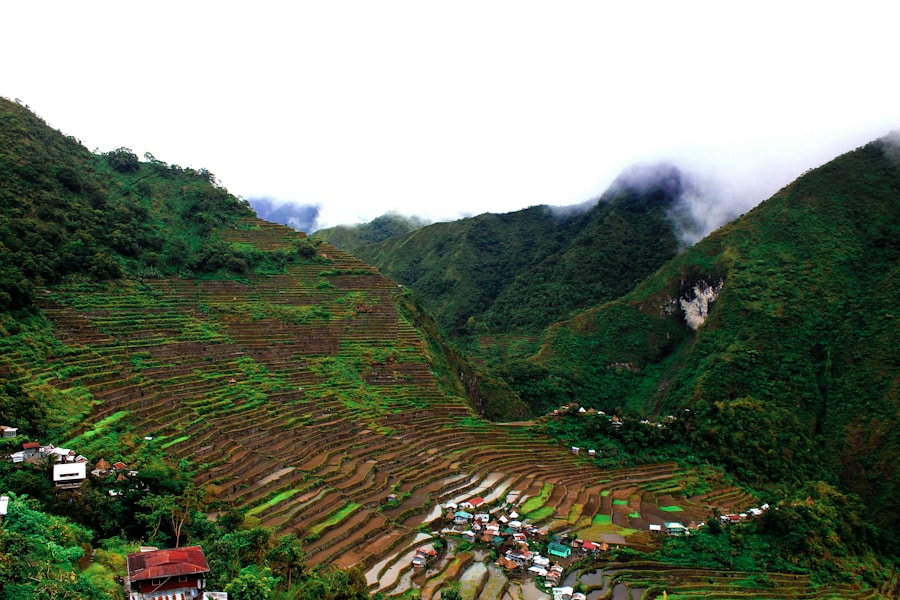
The cultural significance of the Banaue Rice Terraces extends far beyond their agricultural value; they are deeply intertwined with the spiritual beliefs and practices of the Ifugao people. The terraces are often seen as sacred spaces, where rituals and ceremonies are performed to honor ancestral spirits and seek blessings for bountiful harvests. The Ifugao have a rich tapestry of myths and legends surrounding rice cultivation, which further emphasizes the spiritual connection they have with these landscapes.
The Preservation Efforts for the Banaue Rice Terraces
| Preservation Efforts | Metrics |
|---|---|
| Restoration Projects | Number of terraces restored |
| Community Engagement | Number of local farmers involved |
| Government Support | Amount of funding allocated |
| Tourism Management | Visitor numbers and impact on terraces |
| Environmental Conservation | Efforts to prevent erosion and maintain biodiversity |
Preserving the Banaue Rice Terraces has become increasingly critical in recent years due to various threats such as climate change, urbanization, and changing agricultural practices. Local government units, non-governmental organizations, and community groups have initiated several preservation efforts aimed at safeguarding this UNESCO World Heritage site. One significant initiative is the establishment of programs that promote sustainable farming practices among local farmers.
These programs emphasize traditional methods that have proven effective over centuries while integrating modern techniques that enhance productivity without compromising environmental integrity. In addition to agricultural initiatives, there are ongoing efforts to raise awareness about the cultural significance of the rice terraces among younger generations. Educational programs in schools focus on teaching students about their heritage and instilling a sense of pride in their cultural identity.
Community workshops and training sessions are also organized to equip locals with skills in terrace maintenance and restoration. These efforts aim to ensure that knowledge about traditional farming practices is not lost but rather revitalized for future generations. Furthermore, collaborations with international organizations have brought in resources and expertise to support conservation projects, highlighting the global importance of preserving this unique cultural landscape.
The Best Times to Visit the Banaue Rice Terraces
Visiting the Banaue Rice Terraces offers a unique opportunity to experience one of the most breathtaking landscapes in the world. The best times to visit largely depend on what visitors hope to see and experience during their trip. Generally, the dry season from November to April is considered ideal for exploring the terraces.
During this period, visitors can enjoy clear skies and pleasant weather, making it easier to hike along the terraces and take in panoramic views without being hindered by rain or mud. However, those interested in witnessing the vibrant agricultural activities should consider visiting during the planting season from May to June or during harvest time from September to October. During these months, visitors can observe local farmers engaged in traditional rice planting and harvesting practices, providing a deeper understanding of the cultural significance of these activities.
The lush green landscape during planting season is particularly stunning, while harvest time showcases golden fields ready for collection. Each season offers a unique perspective on life in Banaue, allowing visitors to appreciate both its natural beauty and cultural richness.
The Impact of Tourism on the Banaue Rice Terraces

Tourism has had a profound impact on the Banaue Rice Terraces, bringing both opportunities and challenges to this UNESCO World Heritage site. On one hand, increased tourism has provided economic benefits to local communities through job creation in hospitality, guiding services, and local crafts. Many residents have found new sources of income by offering homestays or selling handicrafts to visitors eager to take home a piece of Ifugao culture.
This influx of tourists has also raised awareness about the importance of preserving these terraces and has led to greater support for conservation efforts.
The increased foot traffic can lead to soil erosion and damage to terrace walls if not managed properly.
Additionally, some locals express concerns about cultural commodification, where traditional practices may be altered or commercialized to cater to tourist expectations rather than preserving their authentic significance. Balancing tourism development with conservation efforts is crucial for ensuring that both visitors and locals can benefit from this unique cultural landscape without compromising its integrity or sustainability. In conclusion, while tourism can provide economic opportunities for local communities surrounding the Banaue Rice Terraces, it is essential to approach it with sensitivity and respect for both the environment and cultural heritage.
Sustainable tourism practices must be prioritized to ensure that this remarkable site continues to thrive for future generations while allowing visitors to appreciate its beauty and significance fully.
FAQs
What are the Banaue Rice Terraces?
The Banaue Rice Terraces are ancient terraces carved into the mountains of Ifugao in the Philippines. They are often referred to as the “Eighth Wonder of the World” and are a UNESCO World Heritage Site.
How were the Banaue Rice Terraces created?
The terraces were hand-carved over 2,000 years ago by the ancestors of the indigenous Ifugao people using minimal equipment. They were created to make the mountainous terrain suitable for rice cultivation.
What is the significance of the Banaue Rice Terraces?
The terraces are not only a stunning example of ancient engineering and agricultural practices, but they also hold cultural and spiritual significance for the Ifugao people. They are a symbol of their connection to the land and their ancestors.
How big are the Banaue Rice Terraces?
The terraces cover approximately 10,360 square kilometers of mountainside and are estimated to stretch about 20,000 kilometers if laid end to end.
Can visitors explore the Banaue Rice Terraces?
Yes, visitors are welcome to explore the terraces and the surrounding villages. There are hiking trails and guided tours available for those who want to experience the beauty and history of the area.


